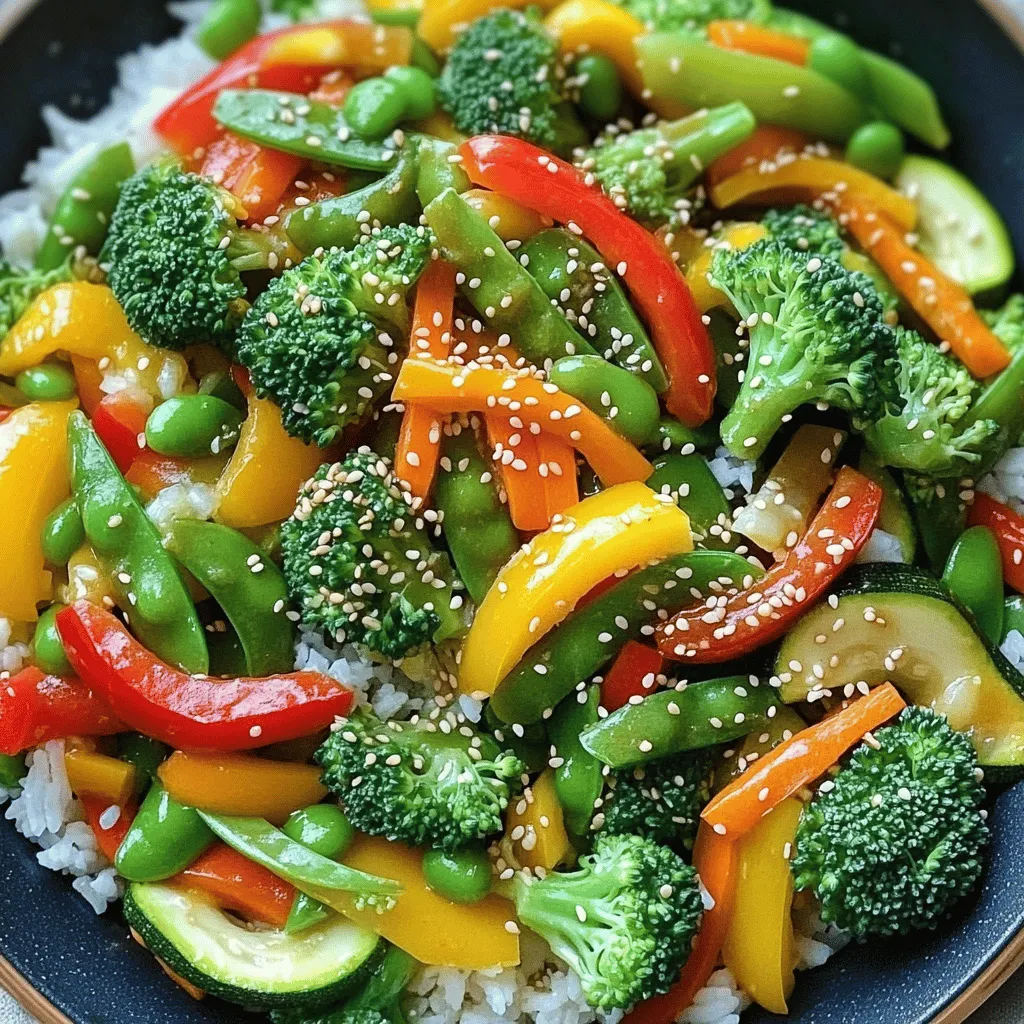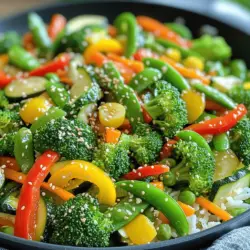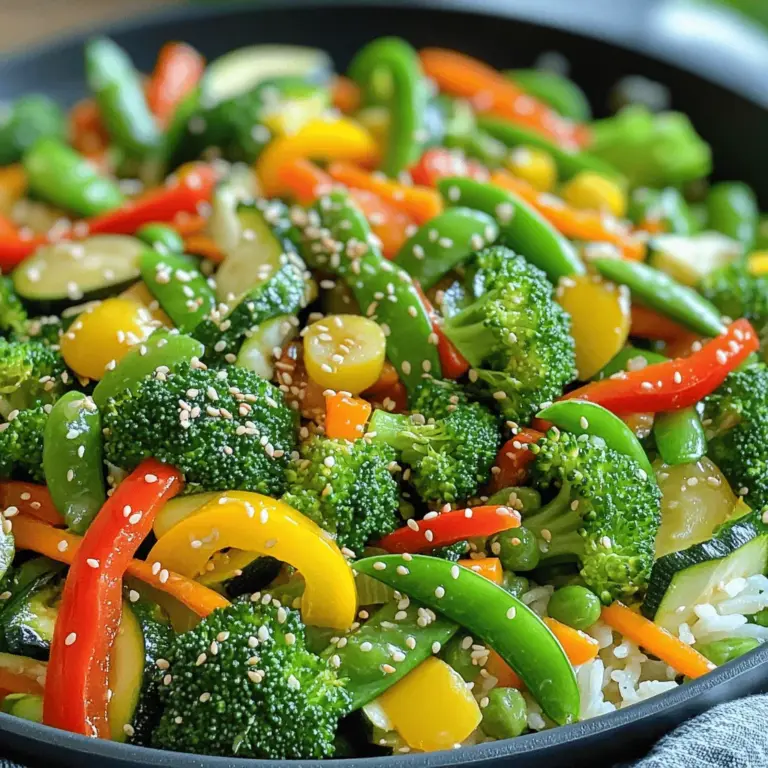Do you want a meal that’s quick, easy, and packed with flavor? Then a vegetable stir-fry is for you! This dish can be made with fresh veggies and simple seasonings. I’ll guide you through every step. From picking the best ingredients to making it taste just right, you’ll have a healthy meal ready in no time. Let’s dive into this delicious stir-fry adventure together!
Ingredients
List of Fresh Vegetables for Stir-Fry
– 1 cup broccoli florets
– 1 cup bell peppers (red, yellow, and green), sliced
– 1 cup snap peas
– 1 medium carrot, julienned
– 1 small zucchini, sliced
Using fresh vegetables makes a big difference in taste. Broccoli adds crunch, while bell peppers give sweetness. Snap peas offer a nice snap, and carrots add color. Zucchini brings a soft texture that complements the other veggies.
Seasoning Essentials
– 3 cloves garlic, minced
– 1 tablespoon fresh ginger, grated
– 3 tablespoons soy sauce (or tamari for gluten-free)
– 1 tablespoon sesame oil
– 1 tablespoon olive oil
– Salt and pepper to taste
Garlic and ginger give a warm flavor base. Soy sauce adds saltiness and depth. Sesame oil brings a nutty taste. Salt and pepper finish the dish, elevating all the flavors.
Other Optional Ingredients
– 1 teaspoon sesame seeds (for garnish)
Sesame seeds not only add crunch but also make the dish look pretty. You can also add other veggies you have on hand. This makes the stir-fry unique and fun to create.
Step-by-Step Instructions
Preparing the Vegetables
First, wash all your vegetables. Clean veggies are key for taste and health. Next, cut your broccoli into small florets. Slice the bell peppers into thin strips. Julienne the carrot and slice the zucchini. Lastly, mince the garlic and grate the ginger. Having everything ready helps the stir-fry cook evenly and quickly.
Cooking Process: Heating and Sautéing
Grab a large skillet or wok. Heat olive oil over medium-high heat. When the oil is hot, add the minced garlic and grated ginger. Sauté them for about 30 seconds until they smell great. Now, toss in the broccoli and carrots. Stir-fry these for 2 to 3 minutes. They should start to soften but still stay crisp.
Next, add the bell peppers and snap peas. Keep stir-frying for another 2 to 3 minutes. All the veggies should be bright and slightly tender. It’s important not to overcook them, as we want a nice crunch.
Adding Flavor: Seasoning the Stir-Fry
Drizzle soy sauce and sesame oil over your veggies. Stir well to coat every piece. Cook for one more minute to let the flavors mix. Finally, season with salt and pepper to taste. Once done, remove the skillet from heat. Transfer your colorful stir-fry to a bowl or platter. For a final touch, sprinkle sesame seeds on top. Enjoy your tasty and healthy meal!
Tips & Tricks
How to Achieve the Perfect Crisp Texture
To get that perfect crisp, keep your heat high. Use a large skillet or wok. This gives the vegetables space to cook quickly. Don’t overcrowd the pan. If you add too many veggies at once, they will steam instead of stir-fry. Stir constantly to keep them moving. This helps all sides cook evenly.
Timing for Cooking Different Vegetables
Each vegetable has its own cooking time. Start with the harder ones first. Broccoli and carrots need more time. Add bell peppers and snap peas later, as they cook faster. Here’s a quick guide:
– Broccoli: 2-3 minutes
– Carrots: 2-3 minutes
– Bell Peppers: 1-2 minutes
– Snap Peas: 1-2 minutes
Pay attention to their colors. Bright green and vivid shades mean they’re done!
Serving Suggestions & Enhancements
For a great meal, serve your stir-fry over rice or quinoa. This adds a nice touch and makes it filling. You can also add fresh herbs, like cilantro, on top. A sprinkle of sesame seeds adds crunch. For a spicy kick, try drizzling sriracha or chili oil. Want something different? Pair this stir-fry with a light soup. It complements the meal well.

Variations
Protein Add-Ins for a Heartier Meal
You can easily add protein to your vegetable stir-fry. Try tofu, chicken, or shrimp. Each option adds flavor and makes the meal more filling. For tofu, use firm or extra firm. Cut it into cubes and sauté until golden. For chicken, slice it thinly and cook until no longer pink. Shrimp cooks fast, so add it near the end. This addition boosts nutrition and makes your dish more satisfying.
Alternative Sauces and Marinades
Soy sauce is great, but you can switch it up! Try teriyaki sauce for sweetness or hoisin sauce for a rich flavor. If you want a kick, add sriracha or chili paste. For a tangy taste, use lemon juice or rice vinegar. Marinating your protein before cooking adds depth. Just mix your sauce and let the protein sit for 30 minutes.
Seasonal Vegetable Swaps
Using seasonal veggies can enhance your stir-fry. In spring, add asparagus and snap peas. Summer is perfect for zucchini and corn. In fall, try carrots and bell peppers. Winter often brings hearty greens like kale. You can mix and match based on what’s fresh. This keeps your meal exciting and supports local farmers.
Storage Info
Best Practices for Refrigeration
To keep your vegetable stir-fry fresh, store it in an airtight container. Make sure it is completely cool before sealing. Place it in the fridge within two hours of cooking. This helps prevent bacteria growth. You can store it for up to three days. When you’re ready to eat, check for any off smells or changes in texture. If it seems fine, you can enjoy it again.
Freezing Tips for Leftovers
If you want to save your stir-fry for later, freezing is a great option. Allow it to cool completely before packing it. Use a freezer-safe container or a heavy-duty freezer bag. Make sure to remove as much air as possible to avoid freezer burn. You can freeze it for up to three months. Label the bag with the date to keep track. Thaw it overnight in the fridge before reheating.
Reheating Methods to Retain Flavor
When reheating your stir-fry, you want to keep it tasty. The best way is to use a skillet. Add a splash of water or broth to help steam the veggies. Heat it over medium heat, stirring gently. This helps keep the vegetables crisp. You can also use a microwave if you’re short on time. Cover the dish and heat in short bursts, stirring in between. This ensures even heating without overcooking.
FAQs
Can I make this stir-fry ahead of time?
Yes, you can make this stir-fry ahead of time. Cook the vegetables and store them in the fridge. They will stay fresh for up to three days. When you’re ready to eat, heat the stir-fry in a pan. You can add a splash of soy sauce to refresh the flavor. This saves time on busy days and still gives you a tasty meal.
What are some good sides to serve with vegetable stir-fry?
Great sides for vegetable stir-fry include:
– Steamed rice
– Quinoa
– Noodles
– Crispy spring rolls
– A fresh salad
These sides add variety and help round out the meal. You can also serve a light soy sauce or sweet chili sauce for dipping. Each option complements the stir-fry well and boosts your meal’s flavor.
How do I make a vegetable stir-fry vegan-friendly?
To make this stir-fry vegan-friendly, use plant-based sauces. Replace regular soy sauce with a gluten-free version if needed. Make sure your oils are vegan, which they usually are. You can also add tofu or tempeh for extra protein. This keeps your meal healthy and satisfying without any animal products. Enjoy this delicious dish knowing it fits your diet!
Stir-frying is simple and fun. We covered fresh veggies, seasonings, and cooking tips. You learned how to achieve a crispy texture and paired your dish with proteins and sauces. We also explored storage methods to keep leftovers tasty. Remember, you can make this dish suit your taste and diet. Experiment with different veggies and flavors. Enjoy your cooking!


